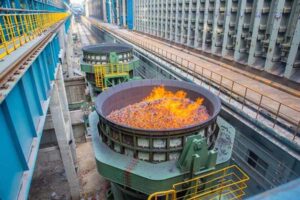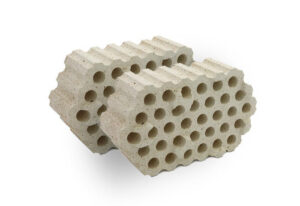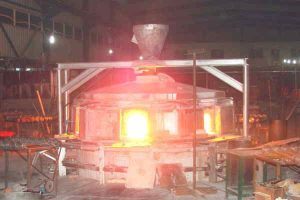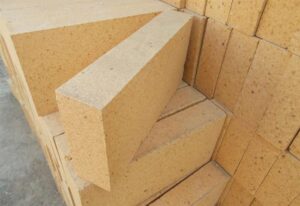Refractory Silica Brick
01. Silica fire brick is an acid-refractory material, with good resistance to acid slag erosion, and load softening temperature of up to 1640 ~ 1670 ℃, the volume of long-term use at high temperatures is relatively stable.
02. It is mainly used in the partition wall of the charring room and combustion room of the coke oven, the heat storage room and slagging room of the steel-making flat furnace, equalization furnace, refractory material of the glass melting kiln and ceramic firing kiln, etc., and other load-bearing parts of the kiln’s vaults and so on. It is also used in the high-temperature load-bearing part of hot blast furnaces and the roof of acid-flat furnaces.
![]()
03. It is mainly acidic refractory material composed of scaled quartz, square quartz, and a small amount of residual quartz and glass phase. Silicon dioxide content of 94% or more. True density 2.35g/cm3.
Resistant to acidic slag erosion. Higher high-temperature strength. Load softening start temperature 1620~1670℃. No deformation under high temperature for long-term use. Low thermal shock stability (heat exchange in water is 1~4 times).
Natural silica as raw material, plus an appropriate amount of mineralizing agent, to promote the transformation of quartz in the body of the blank to, scale quartz. Slowly fired under reducing atmosphere by 1350 ~ 1430 ℃.
Heating to 1450 ℃ about 1.5 ~ 2.2% of the total volume expansion, this residual expansion will cut joints close, to ensure that the masonry body has good airtightness and structural strength.
Scalar quartz, argillaceous quartz, and residual quartz have large changes in volume at low temperatures due to changes in crystal type, so the thermal stability of silica bricks at low temperatures is poor.
During use, it should be heated and cooled slowly below 800℃ to avoid cracks. Therefore, should not be used in 800 ℃ below the temperature of the rapid change in the kiln.
04. The nature and process of silica bricks are closely related to the crystalline transformation of SiO2. Therefore, the true specific gravity is an important quality indicator of silica bricks.
General requirements in 2.38 or less, high-quality silica refractory bricks should be 2.35 or less. True specific gravity is small, reflecting the brick in the number of scale quartz and square quartz, residual quartz amount is small, so the residual linear expansion is small, and the use of strength decline is also less.
Silicon dioxide has seven crystalline variants and one amorphous variant. These variants can be divided into two categories: the first type of variant is quartz, quartz, and quartz, their crystalline structure is very different, and the transformation between each other is very slow. The second type of variant is a subspecies of the above variants – α β and γ type, their structure is similar, and the transformation between each other is faster.
05. The raw material for the manufacture of silica bricks is silica. In Silica raw materials, the higher the SiO2 content, the higher the refractoriness. The most harmful impurities are Al2O3, K2O, Na2O, etc., they seriously reduce the refractoriness of refractory products.
Silica bricks are made from silica with SiO2 content of not less than 96%, adding mineralizing agent (e.g., iron scale, milk of lime) and binding agent (e.g., molasses, sulfite pulp waste liquid), and produced by mixing, molding, drying, and sintering processes.
Silica bricks are mainly used in coke ovens, glass furnaces, acid steel furnaces, and other thermal equipment. The following two points should be noted when using silica bricks:
1. When the silica product is at 200~300℃ and 573℃, the volume will expand suddenly due to crystal transformation. Therefore, when baking, the temperature rise below 600℃ should not be too fast, and drastic temperature changes should be avoided when cooling to below 600℃.
2. Avoid contact with alkaline slag as much as possible.
Technical Conditions Of Silica Bricks For Industrial Kilns
Silica Bricks For Coke Ovens
Silica fire bricks for coke ovens are a kind of silica refractory material used to build coke ovens with quartz crystals. Silica bricks for coke oven should have the following characteristics:
1. High load softening temperature. Silica brick for coke oven should be able to withstand the dynamic load of coal loading truck at high temperatures at the top of the furnace, and not be deformed in long-term use. Therefore, the Coke oven silica brick load softening temperature requirements are high.
2. High thermal conductivity. Coke is made from coking coal in the carbonization chamber by conducting heat in the combustion chamber wall. Therefore, the silica bricks used to build the combustion chamber wall should have high thermal conductivity.
3. Good thermal shock resistance. As the coke oven needs to be regularly loaded and coke discharged, the temperature of the silica bricks on both sides of the combustion chamber will change dramatically, so the coke oven silicon bricks are required to have good thermal expansion.
4. High-temperature volume stability.
![]()
Silica Bricks For Glass Kiln
Silica brick for glass kilns is quartz as the main component of silica refractory materials, used in the construction of glass kiln high-temperature components. Silica bricks for glass kilns should have the following characteristics:
1. Stable high-temperature volume, the furnace body will not change due to temperature fluctuations.
2. No pollution to the glass liquid.
3. Resistant to chemical erosion.
4. Small bulk density.
PER Refractories company produces a large amount of silica brick, many varieties, mainly used in coke ovens, carbonization chambers, combustion chambers and partition walls and glass kiln roofs, kiln pools. There are also high-temperature load-bearing parts of the hot blast stove, carbon roasters, and other kilns that also use alumina silica bricks for the lining.




